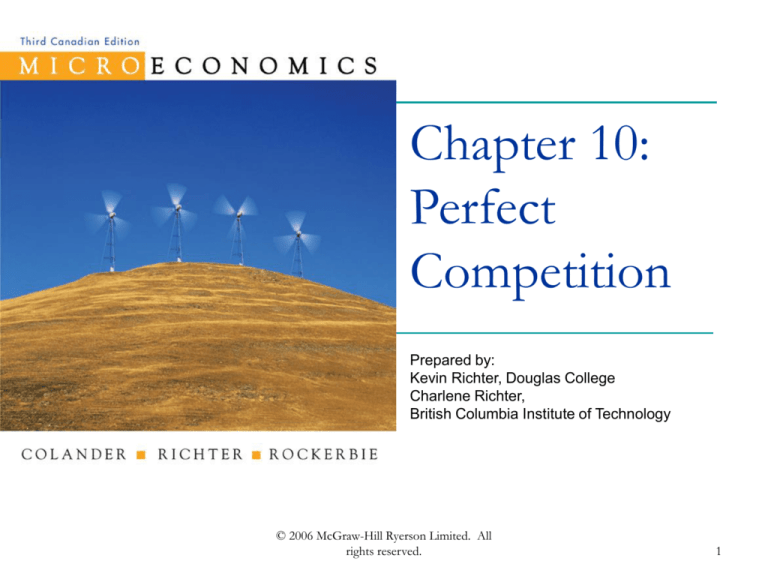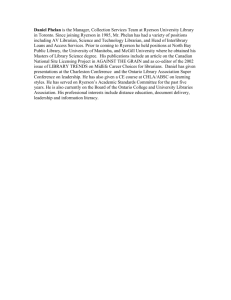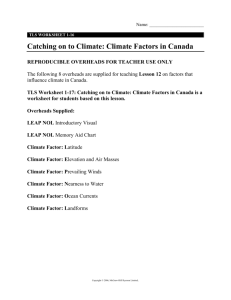
Chapter 10:
Perfect
Competition
Prepared by:
Kevin Richter, Douglas College
Charlene Richter,
British Columbia Institute of Technology
© 2006 McGraw-Hill Ryerson Limited. All
rights reserved.
1
Chapter Objectives
1. List the six conditions for a perfectly
competitive market.
2a. Explain why producing an output at which
marginal cost equals price maximizes total
profit for a perfect competitor.
2b. Demonstrate why the marginal cost curve
is the supply curve for a perfectly competitive
firm.
© 2006 McGraw-Hill Ryerson Limited. All
rights reserved.
2
Chapter Objectives
3a. Determine the output and profit of a
perfect competitor graphically and numerically.
3b. Explain the role of profits as market
signals.
4a. Construct a market supply curve by adding
together the marginal cost curves of individual
firms.
4b. Explain why perfectly competitive firms
make zero economic profit in the long run.
© 2006 McGraw-Hill Ryerson Limited. All
rights reserved.
3
Chapter Objectives
5. Explain the adjustment process from shortrun equilibrium to long-run equilibrium.
© 2006 McGraw-Hill Ryerson Limited. All
rights reserved.
4
Perfect Competition
The concept of competition is used in two
ways in economics.
Competition as a process is a rivalry among firms.
Competition as a market structure.
© 2006 McGraw-Hill Ryerson Limited. All
rights reserved.
5
Perfectly Competitive Market
A perfectly competitive market is one in
which economic forces operate unimpeded.
It has highly restrictive assumptions which
provide us with a reference point we can use
in comparing different markets.
© 2006 McGraw-Hill Ryerson Limited. All
rights reserved.
6
Perfectly Competitive Market
In a perfectly competitive market:
The number of firms is large.
The firms' products are identical.
There is free entry and exit, that is, there are no
barriers to entry.
There is complete information.
Firms are profit maximizers.
Both buyers and sellers are price takers.
© 2006 McGraw-Hill Ryerson Limited. All
rights reserved.
7
Necessary Conditions for Perfect
Competition
There is free entry and free exit.
Firms are free to enter a market in response to
market signals such as price and profit.
Barriers to entry are social, political, or economic
impediments that prevent other firms from
entering the market.
© 2006 McGraw-Hill Ryerson Limited. All
rights reserved.
8
Necessary Conditions for Perfect
Competition
Both buyers and sellers are price takers.
A price taker is a firm or individual who takes the
market price as given.
Neither supplier nor buyer possesses market
power.
© 2006 McGraw-Hill Ryerson Limited. All
rights reserved.
9
Demand Curves for the Firm and the
Industry
The demand curve facing the firm is different
from the industry demand curve.
A perfectly competitive firm’s demand
schedule is perfectly elastic even though the
demand curve for the market is downward
sloping.
© 2006 McGraw-Hill Ryerson Limited. All
rights reserved.
10
Market Demand Curve Versus Individual
Firm Demand Curve
Price
$10
Market
Market supply
Firm
Price
$10
8
8
6
6
4
Market
demand
2
0
1,000
3,000 Quantity
A
B
C
Individual firm
demand
4
2
0
10
© 2006 McGraw-Hill Ryerson Limited. All
rights reserved.
20
30
Quantity
11
Profit-Maximizing Level of Output
Marginal revenue (MR) – the change in total
revenue associated with a one-unit change in
quantity.
Marginal cost (MC) – the change in total
cost associated with a one-unit change in
quantity.
© 2006 McGraw-Hill Ryerson Limited. All
rights reserved.
12
Marginal Cost, Marginal Revenue, and
Price
Price = MR Quantity
Produced
$35.00
35.00
35.00
35.00
35.00
35.00
35.00
35.00
35.00
35.00
35.00
0
1
2
3
4
5
6
7
8
9
10
Marginal
Cost
Costs
$28.00
20.00
16.00
14.00
12.00
17.00
22.00
30.00
40.00
54.00
68.00
50
MC
60
40
A
30
A
C
B
P = D = MR
20
10
0
1 2 3 4 5 6 7 8 9 10 Quantity
© 2006 McGraw-Hill Ryerson Limited. All
rights reserved.
13
Marginal Cost Curve Is the Firm’s
Supply Curve
Marginal cost
$70
C
Cost, Price
60
50
40
A
30
B
20
10
0
1
2
3
4
5
6
7
8
© 2006 McGraw-Hill Ryerson Limited. All
rights reserved.
9 10 Quantity
14
Firms Maximize Total Profit
Firms seek to maximize total profit, not profit
per unit.
Firms do not care about profit per unit.
As long as an increase in output yields even a
small amount of additional profit, a profitmaximizing firm will increase output.
© 2006 McGraw-Hill Ryerson Limited. All
rights reserved.
15
Profit Maximization Using Total
Revenue and Total Cost
Total cost, revenue
TC
Loss
$385
350
315 Maximum profit =$81
280
245
210
$130
175
140
105
Profit =$45
70
Loss
35
0
1 2 3 4 5 6 7 8 9
© 2006 McGraw-Hill Ryerson Limited. All
rights reserved.
TR
Profit
Quantity
16
Costs Relevant to a Firm
Profit Maximization for a Competitive Firm
Total
P = MR Output Total Cost Marginal Average
Cost Total Cost Revenue
Profit
TR-TC
—
35.00
35.00
35.00
35.00
35.00
35.00
–40.00
–33.00
–18.00
1.00
22.00
45.00
63.00
0
1
2
3
4
5
6
40.00
68.00
88.00
104.00
118.00
130.00
147.00
—
28.00
20.00
16.00
14.00
12.00
17.00
—
68.00
44.00
34.67
29.50
26.00
24.50
© 2006 McGraw-Hill Ryerson Limited. All
rights reserved.
0
35.00
70.00
105.00
140.00
175.00
210.00
17
Costs
Relevant
to
a
Firm
Profit Maximization for a Competitive Firm
Marginal
Average
Total
P = MR Output Total Cost
Cost Total Cost Revenue
35.00
35.00
35.00
35.00
35.00
35.00
35.00
4
5
6
7
8
9
10
118.00
130.00
147.00
169.00
199.00
239.00
293.00
14.00
12.00
17.00
22.00
30.00
40.00
54.00
29.50
26.00
24.50
24.14
24.88
26.56
29.30
© 2006 McGraw-Hill Ryerson Limited. All
rights reserved.
140.00
175.00
210.00
245.00
280.00
315.00
350.00
Profit
TR-TC
22.00
45.00
63.00
76.00
81.00
76.00
57.00
18
Determine Profit From a Graph
Find output where MC = MR.
The intersection of MC = MR (P) determines
the quantity the firm will produce if it wishes
to maximize profits.
© 2006 McGraw-Hill Ryerson Limited. All
rights reserved.
19
Determine Profits Graphically
MC
MC
Price
Price
65
65
60
60
55
55
50
50
ATC
45
45
40 D
A
P = MR 40
35
35
P = MR
Profit
30
30
B ATC
25 C
25
AVC
AVC
E
20
20
15
15
10
10
5
5
0
0
1 2 3 4 5 6 7 8 9 10 12
1 2 3 4 5 6 7 8 9 10 12
Quantity
Quantity
(a) Economic Profit
(b) Zero economic profit
© 2006 McGraw-Hill Ryerson Limited. All
rights reserved.
Price
65
60
55
50
45
40
35
30
25
20
15
10
5
0
MC
ATC
Loss
P = MR
AVC
1 2 3 4 5 6 7 8 910 12
Quantity
(c) Loss
20
Shutdown Point
The shutdown point is the point at which the
firm will be better off if it shuts down than if it
stays in business.
© 2006 McGraw-Hill Ryerson Limited. All
rights reserved.
21
Shutdown Decision
MC
Price
60
ATC
50
40
Loss
P = MR
30
AVC
20
$17.80
A
10
0
2
4
6
8
© 2006 McGraw-Hill Ryerson Limited. All
rights reserved.
Quantity
22
Profits as Signals
© 2006 McGraw-Hill Ryerson Limited. All
rights reserved.
23
Long-Run Competitive Equilibrium
MC
Price
60
50
SRAC
LRAC
40
P = MR
30
20
10
0
2
4
6
8
© 2006 McGraw-Hill Ryerson Limited. All
rights reserved.
Quantity
24
Long-Run Competitive Equilibrium
In order to stay in business the entrepreneur
must receive his opportunity cost or normal
profits (the amount the owners of business
would have received in the next-best
alternative).
© 2006 McGraw-Hill Ryerson Limited. All
rights reserved.
25
Long-Run Competitive Equilibrium
Normal profits are included as a cost.
Economic profits are profits above normal
profits.
© 2006 McGraw-Hill Ryerson Limited. All
rights reserved.
26
Long-Run Competitive Equilibrium
Firms with super-efficient workers or
machines will find that the price of these
specialized inputs will rise.
Rent is the income received by those
specialized factors of production.
© 2006 McGraw-Hill Ryerson Limited. All
rights reserved.
27
Long-Run Competitive Equilibrium
The zero profit condition is enormously
powerful.
As long as there is free entry and exit, price
will be pushed down to the average total cost
of production.
© 2006 McGraw-Hill Ryerson Limited. All
rights reserved.
28
Increase in Demand
An increase in demand leads to higher prices
and higher profits.
Existing firms increase output.
New firms enter the market, increasing output still
more.
Price falls until all profit is competed away.
© 2006 McGraw-Hill Ryerson Limited. All
rights reserved.
29
Increase in Demand
If input prices remain constant, the market is
a constant-cost industry, and the new
equilibrium will be at the original price but
with a higher output.
© 2006 McGraw-Hill Ryerson Limited. All
rights reserved.
30
Market Response to an Increase in
Demand
Market
Price
Price
Firm
S0SR
$9
7
AC
S1SR
B
C
A
SLR
MC
$9
Profit
7
B
A
D1
D0
0
700
840 1,200 Quantity
0
© 2006 McGraw-Hill Ryerson Limited. All
rights reserved.
1012 Quantity
31
Long-Run Market Supply
Two other possibilities exist:
Increasing-cost industry – factor prices
rise as new firms enter the market and
existing firms expand capacity.
Decreasing-cost industry – factor prices
fall as industry output expands.
© 2006 McGraw-Hill Ryerson Limited. All
rights reserved.
32
Canadian Retail Industry
During the 1990s the Canadian retail industry
illustrated how a competitive market adjusts
to changing market conditions.
© 2006 McGraw-Hill Ryerson Limited. All
rights reserved.
33
Canadian Retail Industry
Many retailers were lost or absorbed by
competitors: Eaton’s, Bretton’s, Pascal’s,
Robinson’s, K-Mart and many others.
Initially, these firms saw their losses as the
temporary result of reduced demand in a
slowing economy.
© 2006 McGraw-Hill Ryerson Limited. All
rights reserved.
34
Canadian Retail Industry
As prices fell, P=MR fell below their ATC.
But since price remained above the AVC,
many firms closed their less profitable
locations and continued to operate.
© 2006 McGraw-Hill Ryerson Limited. All
rights reserved.
35
Canadian Retail Industry
When demand did not recover, firms ran out
of options.
Many firms realized as they moved into the
long run that they have to exit the Canadian
retail industry.
© 2006 McGraw-Hill Ryerson Limited. All
rights reserved.
36
Shutdown Decision
Price
MC
ATC
Loss
AVC
P = MR
Quantity
© 2006 McGraw-Hill Ryerson Limited. All
rights reserved.
37
Perfect Competition
End of Chapter 10
© 2006 McGraw-Hill Ryerson Limited. All
rights reserved.
38





